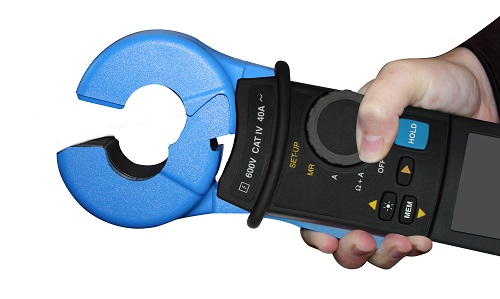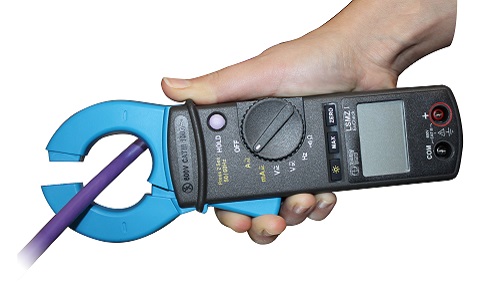Current measuring clamps


A current measuring clamp is a device that can measure direct and alternating current in current-carrying conductors. By means of its ring-shaped measuring terminal, which looks like a pliers head, it can detect the magnetic flux density around the conductor and consequently also the strength of its current. A Hall-effect sensor is located for this at the gap of the measuring terminal. It makes use of the Hall effect which always occurs when a current-carrying conductor is located in a stationary magnetic field. Under the influence of the field, the Lorentz force acts on the electrodes in the conductor. They are deflected, which creates a voltage in the conductor that is vertical to the current and to the direction of the magnetic field. If the magnetic flux density is known in addition to the amount of this voltage, then the strength of the current in the inspected conductor can be calculated. And precisely this task is taken over by current clamps in the conventional sense. Of the devices that are currently in the market most offer further functions such as voltage and resistance measurement.
From the measuring principle, the application of current measuring clamps is derived: As long as the gap of the measuring terminal is large enough, they can be held to any current-carrying conductor – regardless of whether they are supply lines in control cabinets or the cables are routed freely between devices. Current measuring clamps are employed during electrical installations to measure currents on individual derived circuits at distribution panels. In the industrial field it is usual to measure the currents of the supply lines or derived circuits at the switch panel with measuring clamps. Further applications can be found in control circuit cabinets, three-phase induction motors as well as in the range of electromagnetic compatibility (EMC) where interference and leak currents can be detected using current measuring clamps. The most important advantages of current measuring clamps at a glance:
The ferrite core built into the clamp head makes it possible that the measuring clamp does not need to be held at a specific angle to the conductor or that the conductor is guided through the clamp head at a certain distance. It amplifies the magnetic flow in the measuring circuit and compensates errors of measurement that are caused by the irregular routing of the conductor in the measuring circuit.


Current measuring clamps are important aids for checking the functional safety of machines and plants and to detect potential hazard sources. Depending on their technical features, they can also be employed for network diagnosis. At Indu-Sol you receive measuring clamps for checking the equipotential bonding and the EMC compatible installation of networked production systems:
Basic knowledge on the topics EMC and equipotential bonding are taught by Indu-Sol in practical EMC training in which the participants are not only trained in the proper measuring with current measuring clamps but also learn about typical sources of interference and counter measures.
We will be happy to help you. Just send me a mail or give me a call.

Stay informed! Receive the latest offers and news about industrial networks and their optimization - conveniently via e-mail.